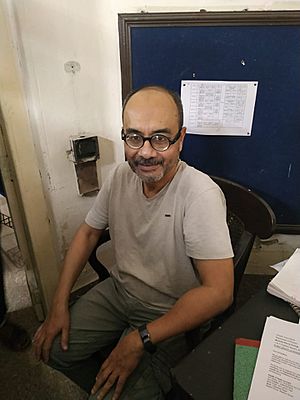Ashoke Sen facts for kids
Quick facts for kids
Ashoke Sen
|
|
|---|---|

Sen in the Physics department of Scottish Church College in 2019
|
|
| Born | 15 July 1956 Kolkata, West Bengal, India
|
| Alma mater |
|
| Known for | Contributions to string field theory S-duality Sen Conjecture |
| Spouse(s) | Sumathi Rao |
| Awards |
|
| Scientific career | |
| Fields | Physics |
| Institutions |
|
| Doctoral advisor |
|
Ashoke Sen is a famous Indian theoretical physicist. He is a professor at the International Centre for Theoretical Sciences (ICTS) in Bangalore. He is also an honorary fellow at the National Institute of Science Education and Research (NISER) in India.
Professor Sen is well-known for his work in string theory. This is a complex area of physics that tries to explain how the universe works. He was one of the first people to receive the Breakthrough Prize in Fundamental Physics. He earned this award for showing that different string theories are actually connected. They are all parts of one bigger theory.
Early Life and Education
Ashoke Sen was born on July 15, 1956, in Kolkata, India. His father, Anil Kumar Sen, was a physics professor. His mother, Gouri Sen, was a homemaker.
He finished his schooling at Sailendra Sircar Vidyalaya in Kolkata. In 1975, he earned his Bachelor of Science degree from Presidency College. A year later, he received his master's degree from the Indian Institute of Technology Kanpur. He then went on to complete his PhD in physics at Stony Brook University.
Amazing Discoveries in Physics
Ashoke Sen has made many important contributions to string theory. One of his key ideas was about something called S-duality. This idea helped change how scientists thought about string theory research.
He also started studying unstable D-branes. These are special objects in string theory. He came up with the famous Sen conjecture. This idea explains what happens when certain particles, called tachyons, disappear. His work on "rolling tachyons" has also been important for understanding the early universe. He has also written many important papers about string field theory. This is a way to describe how strings interact.
In 1998, he became a Fellow of the Royal Society. This is a very respected group of scientists. He was nominated by the famous physicist Stephen Hawking. Professor Sen's work also includes understanding black hole entropy. This is about counting the tiny parts that make up black holes. He has also helped develop new ideas in string perturbation theory.
He joined the National Institute of Science Education and Research (NISER) as an Honorary Professor. In 2020, he also became a visiting professor at the Indian Institute of Science Education and Research, Bhopal (IISER Bhopal). Today, he continues his work on string theory as a distinguished professor at the International Centre for Theoretical Sciences (ICTS) in Bangalore.
Awards and Honors
Ashoke Sen has received many awards for his scientific work:
- ICTP Prize in 1989
- Fellow of the Indian Academy of Sciences in 1991
- S.S. Bhatnagar award in 1994
- TWAS Prize in 1997
- Fellow of the Royal Society in 1998
- Fellow of the Indian National Science Academy in 1996
- Padma Shri in 2001 (a high civilian award in India)
- Infosys Prize in Mathematical Sciences in 2009
- Fundamental Physics Prize in 2012, for his work on string theory
- Padma Bhushan in 2013 (another high civilian award in India)
- M.P. Birla Memorial Award in 2013
- Dirac Medal in 2014
Gallery


